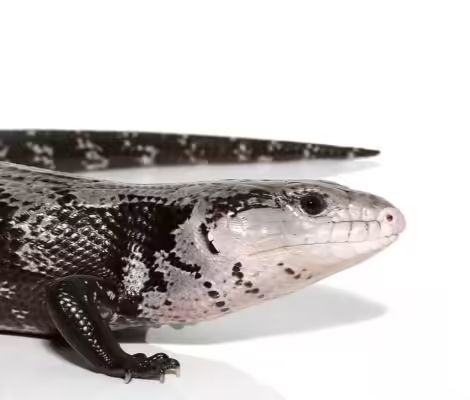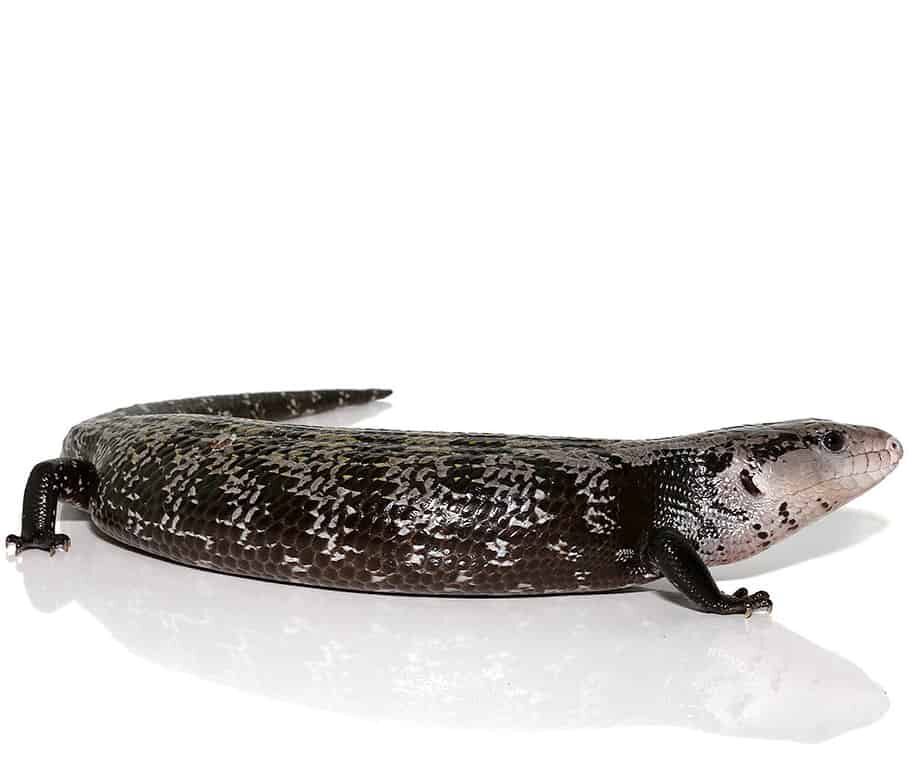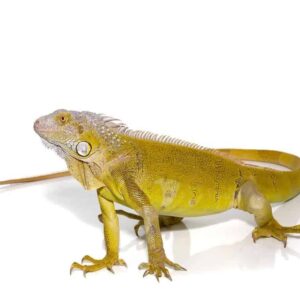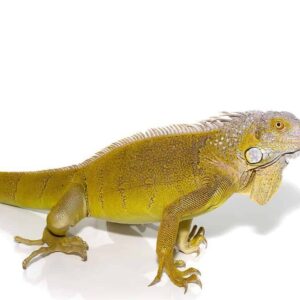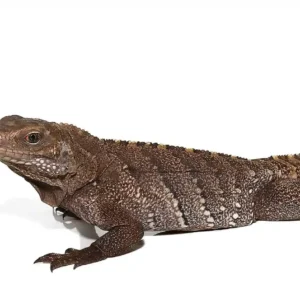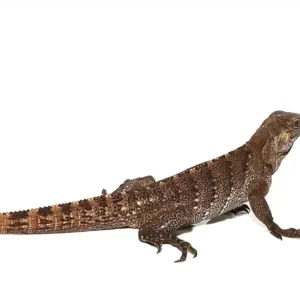Axanthic Halmahera Blue Tongue Skink For Sale
$799.99
WE HAVE A AXANTHIC HALMAHERA BLUE TONGUE SKINK FOR SALE. HERE ARE SOME HIGHLIGHTS:
- Tiliqua gigas
- Farm Bred
- Approximately 18 Inches In Length From Head To Tail
- Adults Are Growing To Sizes Around 15 – 20 Inches In Length From Head To Tail
- Voracious Foragers Eating Veggies, Canned Diet, And Live Insects In Captivity
FUN FACTS!
- These Make Excellent Pets, Tame, Curious and Tons Of Personality
- Stunning Animals That Look Almost Unreal With Their Black And Silver Appearance
- Native To Indonesia, Papua New Guinea And Other Surrounding Islands
- With Proper Care These Skinks Can Live 12 – 15 Years In Captivity
- We Would Recommend Keeping Them Alone Due To Territorial Behavior, Pair Together For Breeding Purposes Only
- These Are Terrestrial And Enjoy Burrowing, Provide Them With Adequate Hides And Deep Substrate
Description
The Axanthic Halmahera Blue Tongue Skink is a captivating reptile species that has garnered significant attention from reptile enthusiasts and researchers alike. Scientifically classified under the genus Tiliqua, this skink is a distinct variant of the Halmahera Blue Tongue Skink, primarily due to its unique coloration and genetic makeup. These skinks are native to the Maluku Islands in Indonesia, specifically the island of Halmahera, which provides a tropical and humid environment conducive to their thriving.
One of the most intriguing aspects of the Axanthic Halmahera Blue Tongue Skink is its coloration. Unlike the typical vibrant blue tongues found in other skink species, the axanthic variant exhibits a more muted, grayscale palette due to the lack of yellow pigmentation. This absence of color results in a strikingly beautiful reptile that stands out in any collection. Additionally, the blue tongue, a characteristic feature of these skinks, is prominently displayed when the animal feels threatened, adding to its allure.
In their natural habitat, Axanthic Halmahera Blue Tongue Skinks can be found in a variety of environments, ranging from dense forests to open grasslands. They are known for their adaptability and resilience, which makes them a popular choice for captivity. These skinks are omnivorous, with a diet that includes a mix of fruits, vegetables, and small animals, reflecting their diverse ecosystem.
The appeal of Axanthic Halmahera Blue Tongue Skinks extends beyond their physical characteristics. Their docile temperament and ease of care make them an ideal pet for both novice and experienced reptile keepers. With proper husbandry, these skinks can live for over 20 years in captivity, providing long-term companionship and fascination for their owners.
In essence, the Axanthic Halmahera Blue Tongue Skink is not just a visually striking reptile but also a robust and adaptable species. Its unique traits and manageable care requirements contribute to its growing popularity among reptile enthusiasts worldwide.
Physical Characteristics and Morphology
The Axanthic Halmahera Blue Tongue Skink is a captivating reptile known for its unique physical characteristics. This skink species typically measures between 18 to 24 inches in length, making it one of the larger members of the blue tongue skink family. The robust and elongated body is supported by short, sturdy limbs, which contribute to its distinctive appearance.
One of the most striking features of the Axanthic Halmahera Blue Tongue Skink is its coloration. Unlike typical blue tongue skinks, this morph exhibits a reduced presence of yellow and red pigments due to the ‘axanthic’ trait. This genetic variation results in a predominantly grayscale color palette, featuring shades of black, white, and gray. The lack of warm hues creates a visually stunning and somewhat monochromatic look that is highly prized among reptile enthusiasts.
The scale patterns of the Axanthic Halmahera Blue Tongue Skink further enhance its unique appearance. The scales are arranged in a series of overlapping rows, providing both protection and flexibility. These scales often display intricate patterns, with dark bands or spots contrasting against lighter backgrounds. This patterning not only adds to the skink’s aesthetic appeal but also offers some degree of camouflage in its natural habitat.
Another distinguishing feature of the Axanthic Halmahera Blue Tongue Skink is its namesake blue tongue. This vivid blue tongue serves as a defense mechanism, startling potential predators and deterring attacks. When threatened, the skink will open its mouth wide, displaying its bright blue tongue as a warning signal.
The axanthic trait makes this particular morph especially sought after by collectors and breeders. Its unique coloration, combined with the robust build and fascinating scale patterns, sets the Axanthic Halmahera Blue Tongue Skink apart from other skink varieties. These physical characteristics not only contribute to its popularity but also make it a subject of ongoing interest and study within the herpetological community.
Natural Habitat and Geographic Distribution
The Axanthic Halmahera Blue Tongue Skink, a remarkable reptile species, is indigenous to the Halmahera Island in Indonesia. This tropical paradise is characterized by its lush, dense rainforests, which offer an ideal environment for these skinks. The island’s equatorial location ensures a warm and humid climate year-round, with temperatures typically ranging from 25°C to 30°C (77°F to 86°F) and humidity levels often exceeding 80%. Such climatic conditions are crucial for the skinks’ thermoregulation and overall well-being.
The diverse vegetation of Halmahera, comprising thick canopies, understory plants, and abundant leaf litter, provides ample cover and foraging opportunities for the Axanthic Halmahera Blue Tongue Skink. These skinks are primarily ground dwellers and rely heavily on the forest floor for shelter and sustenance. The leaf litter and fallen logs offer both protection from predators and a rich hunting ground for insects, snails, and other invertebrates that constitute their diet.
Moreover, the unique microhabitats within Halmahera’s forests play a significant role in shaping the behavior and physiology of these skinks. The availability of various microclimates within the forest allows the skinks to regulate their body temperature through behavioral thermoregulation. For instance, they may bask in sunlit patches to warm up or retreat to shaded, moist areas to cool down. This adaptability is vital for their survival in the dynamic forest environment.
In terms of geographic distribution, the Axanthic Halmahera Blue Tongue Skink is found predominantly in the lowland and mid-elevation rainforests of Halmahera. These areas offer the optimal combination of temperature, humidity, and vegetation cover that these skinks need to thrive. However, their distribution is limited to regions that provide sufficient forest cover and minimal human disturbance, highlighting the importance of habitat conservation for the survival of this unique species.
Diet and Feeding Habits
The Axanthic Halmahera Blue Tongue Skink, a captivating reptile native to the Halmahera Islands, exhibits intriguing dietary preferences both in the wild and in captivity. In their natural habitat, these skinks are omnivores, consuming a diverse array of food sources. Their diet primarily consists of insects, snails, and other small invertebrates, which provide essential proteins. They also consume a significant amount of plant material, including fruits, flowers, and leafy greens, which contribute vital vitamins and minerals to their diet.
Feeding behavior in the wild is opportunistic, with these skinks foraging both during the day and night. They utilize their keen sense of smell to locate food, often scavenging for carrion or preying on smaller animals. This varied diet ensures they receive a balanced nutritional intake, crucial for their growth and overall health.
In captivity, replicating the natural diet of the Axanthic Halmahera Blue Tongue Skink is essential to maintain their health and well-being. A balanced diet should include a mix of protein sources such as crickets, mealworms, and cooked lean meats, complemented by fresh vegetables and occasional fruits. It is important to note that some fruits can be high in sugar and should be offered sparingly.
Nutritional requirements of these skinks vary at different life stages. Juvenile skinks require more protein to support rapid growth, hence a higher proportion of insects and meat is recommended. Adult skinks, on the other hand, benefit from a diet with more plant-based foods to maintain a healthy weight and prevent obesity. Calcium and vitamin supplements should also be provided, especially in captivity, to prevent deficiencies that could lead to metabolic bone disease.
Feeding frequency should be adjusted according to the skink’s age and size. Juveniles generally require daily feeding, while adults can be fed every other day. Providing a shallow dish of fresh water is essential to ensure proper hydration. By adhering to these dietary guidelines, keepers can ensure their Axanthic Halmahera Blue Tongue Skinks thrive in captivity, mirroring the nutritional balance they would naturally achieve in the wild.
Behavior and Temperament
The Axanthic Halmahera Blue Tongue Skink exhibits a fascinating set of behavioral patterns that make it a unique reptilian pet. These skinks are known for their docile and relatively calm temperament, which makes them suitable for both novice and experienced reptile enthusiasts. Typically, they are solitary creatures, preferring to spend their time alone rather than engaging in social interactions with other skinks, except during the breeding season.
One of the most striking aspects of their behavior is their method of communication. Axanthic Halmahera Blue Tongue Skinks primarily use body language to convey their emotions and intentions. They may hiss or flatten their bodies to appear larger when threatened, a defensive mechanism to ward off potential predators. Additionally, their iconic blue tongues are not just for show; they flash them as a warning signal to deter threats.
In terms of activity levels, these skinks are generally more active during the day, exhibiting diurnal behavior. They enjoy basking under heat lamps, which is crucial for their thermoregulation. However, they also require hiding spots to retreat to when they need to feel secure. When properly acclimated to their environment, they can be quite inquisitive and will often explore their surroundings.
Handling Axanthic Halmahera Blue Tongue Skinks can be a rewarding experience. They tend to tolerate handling well, especially if they are accustomed to human interaction from a young age. It’s important to handle them gently and support their bodies adequately to avoid causing stress. Signs of stress or discomfort in these skinks include excessive hissing, frantic movements, and attempts to escape. Recognizing these signs early can help in adjusting their environment or handling techniques to ensure their well-being.
Overall, the Axanthic Halmahera Blue Tongue Skink’s behavior and temperament make it an intriguing and manageable pet. Understanding their unique behaviors and communication methods can greatly enhance the experience of keeping these remarkable reptiles.
Housing and Environment in Captivity
Creating an ideal captive environment for Axanthic Halmahera Blue Tongue Skinks is paramount to ensuring their health and wellbeing. The first consideration is the enclosure size. For an adult skink, a minimum of a 40-gallon tank is recommended, although larger enclosures are preferable to accommodate their active nature. A horizontal space is crucial as these skinks are terrestrial and require ample room to roam.
Substrate choice is another important aspect. Opt for substrates that mimic their natural habitat and support their burrowing behavior. Reptile bark, coconut husk, and cypress mulch are excellent choices as they retain moisture well, aiding in maintaining the required humidity levels. Avoid substrates like sand or gravel which can pose ingestion risks.
Temperature and humidity are critical to the health of Axanthic Halmahera Blue Tongue Skinks. The enclosure should have a gradient temperature, with a basking spot maintained at 90-100°F and a cooler end around 75-80°F. Nighttime temperatures can drop to 70-75°F. Humidity levels should be kept between 60-80%, which can be achieved by regular misting and using a substrate that retains moisture.
Proper lighting is essential for the overall health of these skinks. Provide a UVB light source to facilitate calcium absorption and prevent metabolic bone disease. The lighting should be on a 12-hour day/night cycle to simulate their natural environment.
Incorporating hiding spots and enrichment activities is vital to reduce stress and promote natural behaviors. Use hides, logs, and foliage to create a secure and stimulating environment. Enrichment activities, such as placing food in different areas, can encourage exploration and mental stimulation.
Maintaining a clean and safe habitat is essential. Regularly spot-clean the enclosure to remove waste and uneaten food. Perform a thorough cleaning of the entire setup every few weeks, ensuring that all surfaces and substrates are disinfected to prevent the growth of harmful bacteria.
By following these guidelines, you can provide a nurturing and healthy environment for your Axanthic Halmahera Blue Tongue Skink, ensuring they thrive in captivity.
Health and Common Medical Issues
Ensuring the health of Axanthic Halmahera Blue Tongue Skinks is pivotal for their well-being and longevity. These reptiles, like any other pets, can encounter various health issues that require prompt attention and care.
One common health concern for these skinks is respiratory infections. These can be caused by suboptimal humidity levels, inadequate temperatures, or poor ventilation in their enclosures. Symptoms to watch for include wheezing, mucus around the nostrils, and lethargy. Prompt veterinary intervention is crucial to prevent the infection from becoming severe. Maintaining proper environmental conditions is key to preventing respiratory issues.
Skin problems are another frequent issue. Skin shedding, or ecdysis, should occur regularly and completely. If the skink has retained shed, particularly around the toes and tail, it could lead to constriction and eventual loss of these body parts. This can be prevented by ensuring the enclosure has adequate humidity and providing rough surfaces for the skink to rub against during shedding. Additionally, any abrasions or cuts should be treated promptly to prevent infections.
Nutritional deficiencies also pose a significant threat to the health of Axanthic Halmahera Blue Tongue Skinks. A balanced diet is essential, incorporating a mix of proteins, fruits, and vegetables. Calcium and vitamin D3 supplements are particularly important to prevent metabolic bone disease, which is characterized by weak or deformed bones. Signs include lethargy, swollen limbs, and difficulty moving. Consultation with a reptile nutrition specialist can help formulate a diet that meets all their nutritional needs.
Preventative care is vital for maintaining the health of these skinks. Regularly cleaning the enclosure, monitoring temperature and humidity levels, and providing a balanced diet can prevent many common health issues. Owners should also be vigilant about changes in behavior or appearance, as these can be early indicators of illness. If any signs of sickness are observed, seeking veterinary help promptly can make a significant difference in the outcome.
Breeding and Reproduction
Breeding Axanthic Halmahera Blue Tongue Skinks necessitates a thorough understanding of their unique mating behaviors and reproductive cycle. These skinks exhibit distinct courtship rituals, which include head bobbing, tongue flicking, and gentle nudging by the male to attract the female. The breeding season typically spans the warmer months, aligning with their natural habitat’s climate.
Once mating occurs, the gestation period for Axanthic Halmahera Blue Tongue Skinks averages between 90 to 120 days. During this time, it is crucial to monitor the pregnant female closely, ensuring she receives a diet rich in calcium and other essential nutrients. Providing a stress-free environment with adequate hiding spots and appropriate temperature gradients is vital for the health of the gravid female.
Unlike many reptiles, Blue Tongue Skinks are live-bearers, meaning they give birth to live young rather than laying eggs. The number of offspring can vary, but it is common for a female to produce 10 to 15 live young per litter. Post-birth, the newborn skinks are relatively independent, but they still require specific care to ensure their survival and proper development.
Newborn skinks should be housed in a separate enclosure from adults to prevent any accidental harm. Their habitat should mimic the conditions of the adults, with a focus on maintaining optimal humidity and temperature. A diet primarily consisting of small insects, finely chopped vegetables, and high-quality commercial skink food will support their rapid growth.
Regular monitoring of the young skinks’ health and development is essential during their early stages. As they grow, they will undergo several shedding cycles, which is a natural part of their development. Ensuring they have access to a humid hide will facilitate a smooth shedding process and promote healthy skin growth.
Overall, successful breeding and care of Axanthic Halmahera Blue Tongue Skinks require a dedicated commitment to understanding their reproductive behaviors and providing the necessary conditions for both the gravid female and her offspring. This meticulous approach ensures the propagation of these fascinating reptiles while maintaining their health and well-being.
